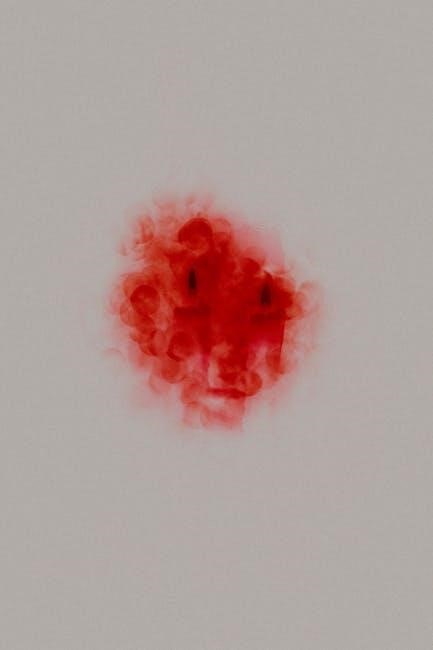Japanese candlestick patterns are foundational tools for price action analysis, offering insights into market sentiment and potential trend reversals. They are widely used in trading strategies, with resources like PDF guides and eBooks providing detailed explanations of various patterns, from basic structures to complex formations, helping traders improve their decision-making skills.
1.1 History of Japanese Candlesticks
Japanese candlesticks originated in 18th-century Japan, primarily used in the Dojima Rice Market to track rice prices. This early application laid the groundwork for their use in modern financial markets, where they are now essential tools for traders analyzing price action and market sentiment. The unique visual representation of price movements through candle shapes and colors provides valuable insights into market behavior, making them indispensable for identifying trends and potential reversals in trading strategies.
1.2 Basic Structure of a Japanese Candlestick
A Japanese candlestick consists of a body, representing the opening and closing prices, and wicks (or shadows), showing the high and low prices during the period. The body is typically colored green or white for upward price action and red or black for downward movements. This structure visually captures market sentiment, with the wicks indicating volatility and the body reflecting price direction. Understanding this basic structure is crucial for interpreting patterns, as it forms the foundation for analyzing trends, reversals, and continuations in financial markets.
Key Trend Reversal Patterns
These patterns signal potential shifts in market trends, such as the Hammer and Shooting Star, often forming at trend extremes and indicating sentiment changes.
2.1 Hammer (Martillo) Pattern
The Hammer pattern is a bullish reversal signal, forming at the end of a downtrend. It features a small real body and a long lower wick, indicating buying pressure overcoming selling pressure. This pattern suggests that bulls are regaining control, potentially leading to a trend reversal. It is often confirmed by a subsequent upward move, making it a reliable indicator for traders seeking entry points during a market bottom.
2.2 Shooting Star (Estrella Fugaz) Pattern
The Shooting Star is a bearish reversal pattern that appears at the end of an uptrend. It consists of a small real body at the lower end of the range and a long upper wick, indicating selling pressure overcoming buying pressure. This pattern signals a potential trend reversal, as it suggests that bulls are losing control. The Shooting Star is often confirmed by a subsequent downward move, making it a valuable indicator for traders to identify potential market highs and adjust their strategies accordingly.
2.3 Engulfing Pattern (Vela Englobante)
The Engulfing Pattern is a powerful reversal indicator in Japanese candlestick analysis. It occurs when a small candlestick is followed by a larger one that “engulfs” it, appearing at the end of a trend. The bearish version, with a green candle followed by a red one, signals a potential downtrend, while the bullish version, with a red candle followed by a green one, indicates an uptrend. This pattern reflects a shift in market sentiment, as the larger candle represents overwhelming buying or selling pressure. Traders often use it to identify trend reversals, but it’s crucial to confirm with other indicators to avoid false signals.
2.4 Dark Cloud Cover (Nube Oscura)
The Dark Cloud Cover is a bearish reversal pattern signaling potential trend weakness. It forms when a white candle is followed by a black candle that opens above the previous high and closes below the midpoint of the white candle. This pattern suggests that bulls are losing control, and bears are gaining momentum. It often appears at market tops, indicating a potential shift in sentiment. Confirmation with other indicators is recommended to avoid false signals, as the pattern alone may not always lead to a sustained downtrend. It is widely recognized in Japanese candlestick analysis for its reliability in forecasting market reversals.

Common Continuation Patterns
Common continuation patterns like Doji, Harami, and Spinning Top indicate market indecision, suggesting the current trend may persist despite temporary pauses or uncertainty.
3.1 Doji Pattern
The Doji pattern is a neutral candlestick formation where the opening and closing prices are nearly identical, creating a small or non-existent body. It indicates market indecision, as neither bulls nor bears gain control. A Doji can appear at the top or bottom of a trend, suggesting a potential reversal, but it often signals a pause or balance in the market. In continuation patterns, a Doji may indicate a temporary hesitation before the trend resumes. Its interpretation depends on the surrounding price action, making it a versatile yet nuanced indicator for traders analyzing patrones de velas japonesas.
3.2 Harami Pattern (Prensa)
The Harami pattern, meaning “pregnant” in Japanese, is a two-candlestick formation where a smaller candle appears inside the body of a larger candle. This pattern suggests a potential pause or reversal in the trend, as it indicates that the opposing force is gaining strength. A white Harami within a downtrend may signal a bullish reversal, while a black Harami within an uptrend could indicate a bearish reversal. It is often seen as a continuation pattern, signaling that the current trend may be losing momentum. Traders use this pattern to identify potential turning points in the market.
3.3 Spinning Top (Peonza)
The Spinning Top, or Peonza, is a candlestick pattern characterized by a small body and long upper and lower wicks, indicating indecision in the market. It forms when buying and selling pressures balance out, suggesting a potential stall in the trend. The pattern can appear in both uptrends and downtrends, signaling that the current momentum may be weakening. While it doesn’t always predict a reversal, it warns of a possible pause or shift in market sentiment. Traders often use the Spinning Top as a caution sign, seeking confirmation from subsequent candles before making trading decisions.

Psychological Insights Behind Candlestick Patterns
Candlestick patterns reveal market emotions, with bulls and bears influencing price action. These patterns reflect sentiment shifts, helping traders understand underlying psychological dynamics driving market trends and decisions.
4.1 Market Sentiment and Price Action
Japanese candlestick patterns are deeply rooted in market sentiment, reflecting the emotional dynamics of traders. Price action, as depicted by these patterns, reveals shifts in confidence between bulls and bears. For instance, a Hammer formation signals bullish reversal potential, indicating buyers regaining control after a decline. Conversely, a Shooting Star highlights bearish sentiment, showing sellers rejecting higher prices. These visual representations of market psychology allow traders to anticipate trend reversals and continuations, making them invaluable tools for understanding price behavior and decision-making in financial markets.
4.2 The Role of Bulls and Bears in Pattern Formation
The interaction between bulls and bears drives the formation of Japanese candlestick patterns, visually representing their struggle. Bulls, or buyers, push prices higher, while bears, or sellers, drive them lower. Patterns like the Hammer or Piercing Line signal bullish strength, indicating buyers are regaining control. Conversely, Shooting Star or Dark Cloud Cover highlight bearish dominance, showing sellers overpowering buyers. The size and color of candlesticks reflect the intensity of these forces, helping traders interpret market sentiment and predict potential trend reversals or continuations based on the balance of power between these two opposing groups.

Individual Confirmation and Continuation Patterns
These patterns signal whether a trend will continue or reverse, helping traders confirm market momentum. They include Piercing Line and Morning Star, which often indicate bullish strength and reversal potential.
5.1 Piercing Line (Línea de Penetración)
The Piercing Line is a bullish reversal pattern that appears after a downtrend. It consists of a black candle followed by a white candle that opens below the previous close but closes above the midpoint of the black candle. This formation indicates a shift in momentum, as bulls regain control, often signaling the end of a decline and the start of an uptrend. The Piercing Line is a reliable signal when confirmed by increased volume or supportive indicators, making it a valuable tool for identifying potential trend reversals in various markets.
5.2 Morning Star (Estrella Matutina)
The Morning Star is a bullish reversal pattern that signals the potential end of a downtrend; It consists of three candles: a black candle, followed by a small candle (often a Doji) that gaps downward, and then a white candle that closes above the midpoint of the first black candle. This formation indicates that bears are losing control, and bulls are regaining strength. The Morning Star is particularly significant when it appears after a prolonged decline, as it suggests a shift in market sentiment and the possibility of an upward trend. Traders often use this pattern to identify potential buying opportunities, especially when confirmed by other indicators or increased volume.
Resources for Learning Japanese Candlestick Patterns

Downloadable PDF guides and eBooks provide comprehensive insights into Japanese candlestick patterns, offering detailed explanations and practical examples for traders to master these essential tools.
6.1 Recommended PDF Guides and eBooks
For in-depth learning, several PDF guides and eBooks are available, such as Patrones de Vela PDF and Manual de Velas Japonesas. These resources provide detailed explanations of candlestick patterns, including trend reversal and continuation signals. They often include practical examples, like the Hammer and Shooting Star patterns, and offer insights into market psychology. These guides are ideal for traders seeking to master Japanese candlestick analysis, offering clear visuals and step-by-step instructions to improve trading strategies. Downloading these materials can enhance your understanding and application of these powerful tools in financial markets.
6.2 Online Courses and Tutorials

Online courses and tutorials are excellent resources for mastering Japanese candlestick patterns. Platforms like Udemy and Coursera offer comprehensive courses that cover basic and advanced topics. These tutorials often include video lessons, quizzes, and practical exercises to help traders apply their knowledge; Many courses focus on real-world examples, such as the Hammer and Shooting Star patterns, to illustrate key concepts. Additionally, some courses provide access to expert instructors who share insights on combining candlestick patterns with modern trading strategies. These resources are ideal for traders seeking structured learning and hands-on experience with Japanese candlestick analysis.
Japanese candlestick patterns continue to evolve with modern trading strategies, integrating AI and machine learning; Their timeless insights remain essential for traders seeking market clarity and precision.
7.1 The Evolution of Candlestick Analysis
Japanese candlestick analysis has evolved significantly since its origins in 18th-century Japan. Initially used for rice trading, it transitioned into financial markets, adapting to modern tools and technologies. Today, advanced software integrates candlestick patterns with AI and machine learning, enhancing predictive capabilities. The rise of digital platforms has made these patterns accessible globally, with resources like PDF guides and eBooks democratizing knowledge. This evolution ensures candlestick analysis remains relevant, aiding traders in diverse markets, from stocks to cryptocurrencies, by combining traditional insights with contemporary innovations for precise and informed decision-making.
7.2 Integrating Candlestick Patterns with Modern Trading Strategies
Integrating Japanese candlestick patterns with contemporary trading strategies enhances market analysis and decision-making. Modern tools like AI, machine learning, and algorithmic trading complement traditional candlestick insights, offering precise signals. Traders now combine these patterns with indicators such as moving averages or RSI for robust strategies. Resources like detailed PDF guides and advanced software enable seamless integration, allowing traders to adapt to dynamic markets. This fusion of old and new techniques empowers traders to identify trends, confirm signals, and manage risks more effectively, ensuring a competitive edge in today’s fast-paced financial landscape while preserving the timeless value of candlestick analysis.
